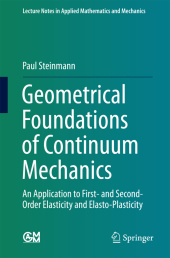 Neuerscheinungen 2015Stand: 2020-02-01 |
Schnellsuche
ISBN/Stichwort/Autor
|
Herderstraße 10
10625 Berlin
Tel.: 030 315 714 16
Fax 030 315 714 14
info@buchspektrum.de |

Paul Steinmann
Geometrical Foundations of Continuum Mechanics
An Application to First- and Second-Order Elasticity and Elasto-Plasticity
2015. 2015. xxiv, 517 S. 59 SW-Abb. 235 mm
Verlag/Jahr: SPRINGER, BERLIN; SPRINGER BERLIN HEIDELBERG 2015
ISBN: 3-662-46459-4 (3662464594)
Neue ISBN: 978-3-662-46459-5 (9783662464595)
Preis und Lieferzeit: Bitte klicken
This book illustrates the deep roots of the geometrically nonlinear kinematics of
generalized continuum mechanics in differential geometry. Besides applications to first-
order elasticity and elasto-plasticity an appreciation thereof is particularly illuminating
for generalized models of continuum mechanics such as second-order (gradient-type)
elasticity and elasto-plasticity.
After a motivation that arises from considering geometrically linear first- and second-
order crystal plasticity in Part I several concepts from differential geometry, relevant
for what follows, such as connection, parallel transport, torsion, curvature, and metric
for holonomic and anholonomic coordinate transformations are reiterated in Part II.
Then, in Part III, the kinematics of geometrically nonlinear continuum mechanics
are considered. There various concepts of differential geometry, in particular aspects
related to compatibility, are generically applied to the kinematics of first- and second-
order geometrically nonlinear continuum mechanics. Together with the discussion on
the integrability conditions for the distortions and double-distortions, the concepts
of dislocation, disclination and point-defect density tensors are introduced. For
concreteness, after touching on nonlinear fir
st- and second-order elasticity, a detailed
discussion of the kinematics of (multiplicative) first- and second-order elasto-plasticity
is given. The discussion naturally culminates in a comprehensive set of different types
of dislocation, disclination and point-defect density tensors. It is argued, that these
can potentially be used to model densities of geometrically necessary defects and the
accompanying hardening in crystalline materials. Eventually Part IV summarizes the
above findings on integrability whereby distinction is made between the straightforward
conditions for the distortion and the double-distortion being integrable and the more
involved conditions for the strain (metric) and the double-strain (connection) being
integrable.
The book addresses readers with an interest in continuum modelling of solids from
engineering and the sciences alike, whereby a sound knowledge of tensor calculus and
continuum mechanics is required as a prerequisite.
Part I Prologue.- Part II Differential Geometry.- Part III Nonlinear Continuum Mechanics.- Part IV Epilogue.
"This new, comprehensive book by P. Steinmann consists of three main parts. ... This book is of very high rigor, scope, and quality, written by an expert in the field, and is thus strongly recommended as a reference for scholars and advanced graduate students. It could also possibly serve as a textbook or supplementary reference for graduate or professional level course(s)." (John D. Clayton, Mathematical Reviews, August, 2015)


